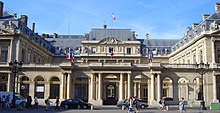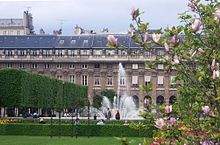Palais Royal
The Palais Royal , formerly Palais Cardinal , is a Parisian city palace in the 1st arrondissement , about 150 meters north of the Louvre . The palace now houses the Council of State (French Conseil d'État ) in its main wing, the Comédie-Française and Constitutional Council (French Conseil constitutionnel ) in the west wing and the Ministry of Culture in the east wing .
history
It was built between 1627 and 1629 by the architect Jacques Le Mercier for the first minister of Louis XIII. , Cardinal Richelieu , after his death in 1642 it became the property of the Crown and took on its current name. After Richelieu, the Queen Mother and Regent Anna of Austria lived in the palace with her two underage sons, Louis XIV and Philippe d'Orléans .
At the time of the Fronde , which raged in Paris and all of France from 1648 to 1653, Louis XIV experienced a night in the Palais Royal that would strongly shape his long absolutist reign. After members of the Paris parliaments, the French courts, revolted against royal decrees of Mazarin and Anna of Austria in 1648 , the regent was forced to live with her two sons, the underage King Louis XIV and his younger brother Philippe, Duke of Anjou, Paris and flee to the royal castle in Saint-Germain-en-Laye to avoid capture by the Frondeurs.
However, the political unrest soon increasingly demanded the presence of the royal family in the capital Paris and so Anna of Austria returned to Paris with her sons in the Palais Royal in 1651. On the night of February 9th to 10th, insurgent Parisians managed, through the cooperation of royal employees, to get into the bedchamber of the young king in order to verify his presence. Ludwig, who pretended to be asleep, lay defenseless in his bed while the rebellious citizens passed him by. The members of the royal family had in fact become prisoners in their besieged palace. Although the young king was not physically harmed that night, the experience at the Palais Royal in Paris was deeply engraved in his memory. Never again did he want to be so powerless and defenseless at the mercy of his subjects, which is evident from later statements by Louis XIV and some domestic political measures. The fact that he made the palace he had commissioned in Versailles into his permanent residence and seat of government in the 1680s goes back in part to his earlier experiences in Paris. Due to its location outside of Paris, the Palace of Versailles was considered a more defensible complex than the royal castles and palaces in central Paris.
In 1636 the palace theater was opened in an annex. The Molière drama company played there from 1660 to 1673 . After his death, the building served as a location for various opera performances until 1763, when it burned down completely on April 6, 1763. At the end of the 18th century the facility was rebuilt. It has served as the headquarters of the Comédie-Française since 1786.
The members of the House of Orléans resided in the Palais Royal since the second half of the 17th century , beginning with Philippe I, the brother of Louis XIV, and his (second) wife Liselotte von der Pfalz . Her son, the regent Philippe II , and Philippe Égalité followed .
On June 8, 1781, there was another fire in the Palais Royal. The opera hall caught fire, which is why the Paris Opera had to move again. The Galerie de Bois was built between 1781 and 1784, around 60 houses with arcades around the palace garden , which housed apartments, shops, restaurants and entertainment facilities. This is where the capital's nightlife is concentrated. The promenade on the "Allée des Soupirs" (Alley of Sighs) was famous all over Europe because the most beautiful girls and women from all classes prostituted themselves there , and people from the high nobility were also found there. Since the complex belonged to the Duke of Orléans , a distant cousin of the king , the police were not allowed to enter. This enabled a certain freedom of assembly and so the palace became a headquarters of the patriotic movement . On July 13, 1789 (according to some sources on July 11 or July 12 ) Camille Desmoulins called for an armed uprising there.
The once infamous gambling halls were closed in 1838.
The residents of the houses at the Jardin du Palais Royal included Sidonie-Gabrielle Colette , Jean Cocteau and Jean Marais .
From 1829 to 1831, after the Galerie de Bois was closed, a new gallery was built in the Palais Royal, the Galerie d'Orléans .
In the course of the numerous arson attacks in the wake of the Paris Commune , the Palais Royal, among others, was partially set on fire.
In the main courtyard ( Cour d'Honneur ) of the Palais Royal, the walk-art plant is located since 1986 Les Deux Plateaux of the French installation artist Daniel Buren .
The Palais Royal in the film
The Palais Royal is used as a backdrop in various films. They include:
- Charade (1963) by Stanley Donen
- Interview with a Vampire (1994) by Neil Jordan
- Hommes, femmes, mode d'emploi (1996) by Claude Lelouch
- The Da Vinci Code (2006) by Ron Howard
- This is Paris (2007) by Cédric Klapisch
- Ca $ h (2008) by Éric Besnard
- Caution Sehnsucht (2009) by Alain Resnais
- Mission: Impossible - Fallout (2018) by Christopher McQuarrie
Individual evidence
- ↑ Malettke, Klaus; Louis XIV of France. Life, politics and performance, Göttingen 1994, p. 45.
- ↑ Wesemann, Eberhard (ed.); Foreword to Robert Andrea de Nerciat: Den Teufel im Leibe, Leipzig 1986, p. 21
- ^ Daniel Buren: Les deux plateaux. Retrieved January 14, 2018 .
literature
- Chris Boicos et al .: Paris . RV Reise- und Verkehrsverlag, Berlin 1994, ISBN 3-89480-901-9 , pp. 119–121.
- Julia Droste-Hennings, Thorsten Droste: Paris. A city and its myth . DuMont-Reiseverlag, Cologne 2003, ISBN 3-7701-6090-8 , pp. 287–289.
- Pierre F. Fontaine: Histoire du Palais-Royal . Thomassin, Paris 1837 (with many plans and views).
- Fritz Stahl: Paris. A city as a work of art . Rudolf Mosse, Berlin 1929.
- René Héron de Villefosse: L'anti-Versailles ou le Palais-Royal de Philippe Egalité . Dullis, Paris 1974, ISBN 2-7083-0010-5 .
- Klaus Malettke : Louis XIV of France. Life, Politics and Achievement. Göttingen 1994, ISBN 3-7881-0143-1 .
Web links
- insecula: Palais Royal (French)
- The Paris Pages: Palais Royal (English)
- Communication structures of the Ancien Régime, 4th Palais-Royal
- Palais Royal and the Galerie d'Orleans in Paris - in Pfennig magazine No. 2 of May 11, 1833
- The Palais Royal-Louvre district: current photos and those from around 1900
Coordinates: 48 ° 51 ′ 48 ″ N , 2 ° 20 ′ 13 ″ E




